A Pair of Comets Are Making a Record-Breaking Pass by Earth
This is the closest a comet has come in 246 years
/https://tf-cmsv2-smithsonianmag-media.s3.amazonaws.com/filer/12/7f/127f28fb-fad0-43aa-97da-ce6f9cce92ef/cometgreen.jpeg)
Just a few hours ago, a comet zipped by the Earth in one of the closest displays in decades. While the nearby comet was a rare event in and of itself, the spectacle didn’t stop there: tomorrow morning, a second one is due to zoom past our planet in the closest encounter with a comet since 1770.
In case this riles up any latent apocalyptic fears, there’s nothing to worry about: this morning’s comet, known as 252P/LINEAR, flew by about 3.3 million miles away. Though it’s coming in a bit closer, tomorrow’s comet (named P/2016 BA14) is still due to pass by about 2.2 million miles away. That’s a little over nine times the distance between the Earth and the moon, Deborah Netburn reports for the Los Angeles Times.
But while that may sound pretty far out there, P/2016 BA14 will be the closest comet to pass by since 1770, and the second-closest comet in all of recorded history.
"There are many more asteroids in near-Earth space than comets, which are significantly more rare," University of Maryland astronomer Michael Kelley tells Netburn. "When a comet does come this close to Earth it is something to get excited about, and take advantage of to learn whatever we can."
Though comets and asteroids can appear similar, they are vastly different in their composition. While asteroids are commonly metallic and rocky, comets are usually made up of ice, dust and rocks.

Astronomers have had their eye on Comet 252P/LINEAR since it was discovered in 2000, but in recent weeks the comet became unexpectedly bright as it approached the sun. In fact, right now the comet is so bright that it can almost be seen by the naked eye, although the quickly-approaching full moon may make it more difficult for stargazers to pick out, even with a telescope or binoculars. For those lucky enough to get a glimpse as the comet heads away from the Earth, they will be treated to a bright green glow as the comet releases diatomic carbon into space, Fiona MacDonald reports for ScienceAlert.
While astronomers have known that 252P/LINEAR was on its way for years, P/2016 BA14’s appearance came as a surprise. The close comet was only discovered in January, and at first surprised astronomers believed it was a rogue asteroid. However, its appearance alongside 252P/LINEAR piqued astronomers’ interest, who took a closer look, MacDonald reports.
"What are the chances of such an unusual comet and a random asteroid having a similar orbit and Earth close approach?" Kelley wrote on his blog last month. "Probably very small! A lot of suspicion was starting to be cast on this so-called asteroid."
Peeking closer at the mysterious object, astronomers not only realized that P/2016 BA14 was a comet, thanks to its gaseous tail, but it is probably related to 252P/LINEAR. While the two comets have slightly different trajectories, P/2016 BA14 likely started off as a fragment of the larger comet that spun off on its own, Bob King writes for Sky & Telescope.
"We know comets are relatively fragile things,” Paul Chodas, manager of NASA’s Center of Near-Earth Object Studies says in a statement. “Perhaps during a previous pass through the inner-solar system, or during a distant flyby of Jupiter, a chunk that we now know of as BA14 might have broken off of 252P."
For now, astronomers are eagerly awaiting the second comet’s passing, with instruments including the Hubble Space Telescope ready to gather as much data as they can on the comet. The P/2016 BA14 comet is scheduled to pass by the Earth at about 10:30 AM EST tomorrow morning, but those who still want to watch can catch a glimpse online at the Virtual Telescope Project.